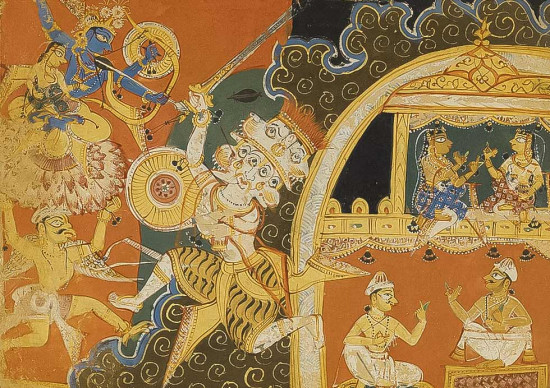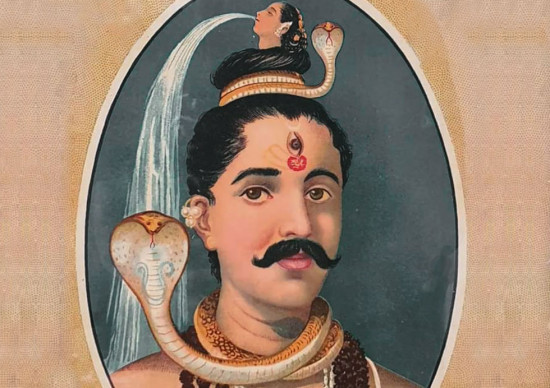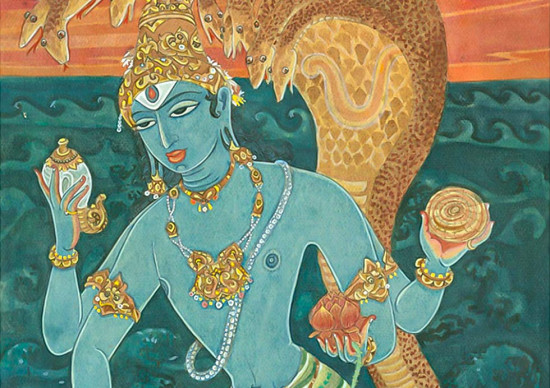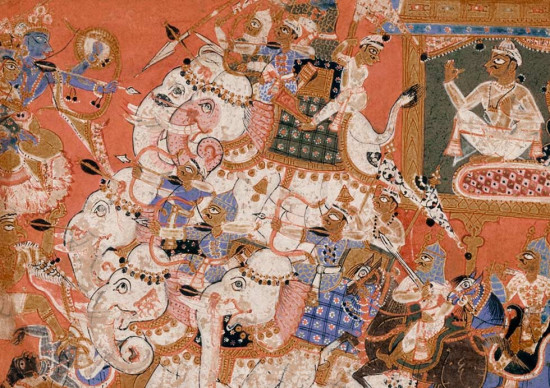In the rich tapestry of Hindu iconography, the representation of deities often transcends mere visual appeal and delves into the profound realms of mythology and symbolism. One such captivating portrayal is that of Lord Shiva as Gajasamhara Murti, a dynamic and fierce form depicted in sculptures, intricately described in iconographical treatises, and steeped in mythological significance.
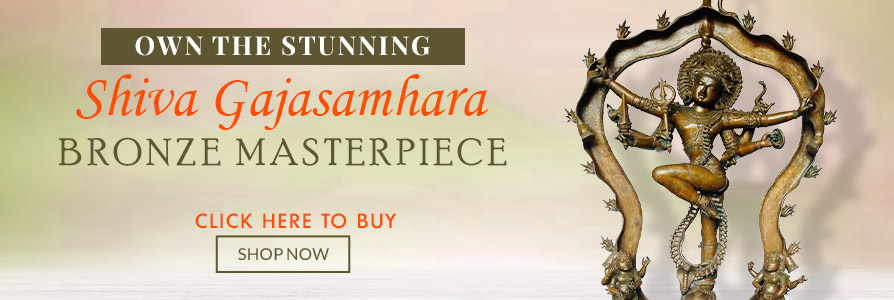
Iconographical Details
According to the ancient text called Amshumadbhedagama, it vividly describes the divine dance of Shiva as Gajasamhara. In this celestial dance, Shiva is depicted inside the skin of a slain elephant, arranged like an aureole around him, forming a prabhamandala. The imagery is captivating, with Shiva’s left leg resting on the head of the elephant, while the right leg is bent and raised above the left thigh in the utkutikasana posture. Clad in silk and tiger skin garments, adorned with various ornaments, Shiva exudes a deep red color.
The representations of Gajasurasamhara vary, showing Shiva with either four or eight arms. In the four-armed depiction, Shiva holds a noose (pasha) in one right hand, the elephant tusk in a left arm, while the other arms gracefully stretch out the skin of the slain elephant. In the eight-armed form, Shiva wields a trident (trishula), a drum (damaru), a noose (pasha), and the elephant skin in his right arms. The left hands showcase the vismaya mudra (sign of astonishment), along with holding a skull cup (kapala), the elephant tusk, and the elephant skin.
Another fascinating depiction in the same text describes an eight-armed form where Shiva holds a trident, a sword, the elephant tusk, and the elephant skin in the left arms. The right hands grasp a skullcup, a shield, a bell (ghanta), and the elephant skin. Interestingly, on the left side of Shiva, his consort Parvati stands with their son Skanda in her arms, both trembling in fear of this fierce aspect of Shiva.
The Suprabhedagama, another ancient scripture, outlines a ten-armed Gajasurasamhara. In this form, Shiva holds a rosary (akshamala), a sword, a power-weapon (shaktyayudha), a staff (danda), and a trident in the right hands. The left hands bear a skull-staff (khatvanga), a snake, a skull, a shield, and a deer.
These intricate descriptions not only capture the dynamic essence of Shiva’s celestial dance but also showcase the divine symbolism and the presence of Parvati and Skanda in the cosmic narrative.
The representations of Gajasurasamhara vary, showing Shiva with either four or eight arms. In the four-armed depiction, Shiva holds a noose (pasha) in one right hand, the elephant tusk in a left arm, while the other arms gracefully stretch out the skin of the slain elephant. In the eight-armed form, Shiva wields a trident (trishula), a drum (damaru), a noose (pasha), and the elephant skin in his right arms. The left hands showcase the vismaya mudra (sign of astonishment), along with holding a skull cup (kapala), the elephant tusk, and the elephant skin.
Another fascinating depiction in the same text describes an eight-armed form where Shiva holds a trident, a sword, the elephant tusk, and the elephant skin in the left arms. The right hands grasp a skullcup, a shield, a bell (ghanta), and the elephant skin. Interestingly, on the left side of Shiva, his consort Parvati stands with their son Skanda in her arms, both trembling in fear of this fierce aspect of Shiva.
The Suprabhedagama, another ancient scripture, outlines a ten-armed Gajasurasamhara. In this form, Shiva holds a rosary (akshamala), a sword, a power-weapon (shaktyayudha), a staff (danda), and a trident in the right hands. The left hands bear a skull-staff (khatvanga), a snake, a skull, a shield, and a deer.
These intricate descriptions not only capture the dynamic essence of Shiva’s celestial dance but also showcase the divine symbolism and the presence of Parvati and Skanda in the cosmic narrative.
Depictions in Sculpture
Shiva as Gajasamhara is often depicted with eight or sixteen arms, a rarity in Shiva’s iconography reserved for his combative forms. The multiple arms carry attributes like the trishula, damaru, sword, kapala, pasha, deer, goad, thunderbolt, arrow, mace, skull-staff, chisel-like weapon, bow, snake, the elephant’s tusk, and rosary. Shiva’s face is fearsome, with round rolling eyes and protruding fangs, while his head is adorned with a matted hair crown and garlands of skulls.
In this statue, Shiva’s right leg is on the elephant’s head, and the left leg is slightly lifted, suggesting a dynamic dance. In Chola sculptures, the right leg often rests on the elephant’s head, and the left leg is bent and raised, defying the traditional iconographical descriptions.
In this statue, Shiva’s right leg is on the elephant’s head, and the left leg is slightly lifted, suggesting a dynamic dance. In Chola sculptures, the right leg often rests on the elephant’s head, and the left leg is bent and raised, defying the traditional iconographical descriptions.
Legend of Gajasamhara Shiva
In ancient times, there was a powerful demon named Gajasura who took the form of an elephant. This demon had gained immense strength and was causing havoc, disturbing the balance of the cosmos. His arrogance and malevolence grew to a point where even the Devas (celestial beings) were unable to withstand his tyranny.
Witnessing the chaos caused by Gajasura, the Devas approached Lord Shiva and sought his intervention. In response to their plea, Lord Shiva took the formidable form of Gajasamhara to confront and vanquish the malevolent elephant demon.
The cosmic dance of Gajasamhara Shiva is a mesmerizing and powerful event. It symbolizes the triumph of divine forces over demonic elements, restoring balance to the universe. In the course of this cosmic dance, Lord Shiva subdues Gajasura, symbolizing the destruction of ego, ignorance, and negativity.
Witnessing the chaos caused by Gajasura, the Devas approached Lord Shiva and sought his intervention. In response to their plea, Lord Shiva took the formidable form of Gajasamhara to confront and vanquish the malevolent elephant demon.
The cosmic dance of Gajasamhara Shiva is a mesmerizing and powerful event. It symbolizes the triumph of divine forces over demonic elements, restoring balance to the universe. In the course of this cosmic dance, Lord Shiva subdues Gajasura, symbolizing the destruction of ego, ignorance, and negativity.
Mythological Significance
The mythology surrounding Gajasamhara is rooted in the cosmic narratives of Lord Shiva. Legend has it that Nandi, originally a sage named Shilada, sought an immortal son through intense penance. Lord Shiva granted this wish with a unique condition – the son would be immortal only as long as he remained in the form of a bull. This son, named Nandi, later became Gajasurasamhara, appointed as the chief of Shiva’s ganas and guardian of Kailash.
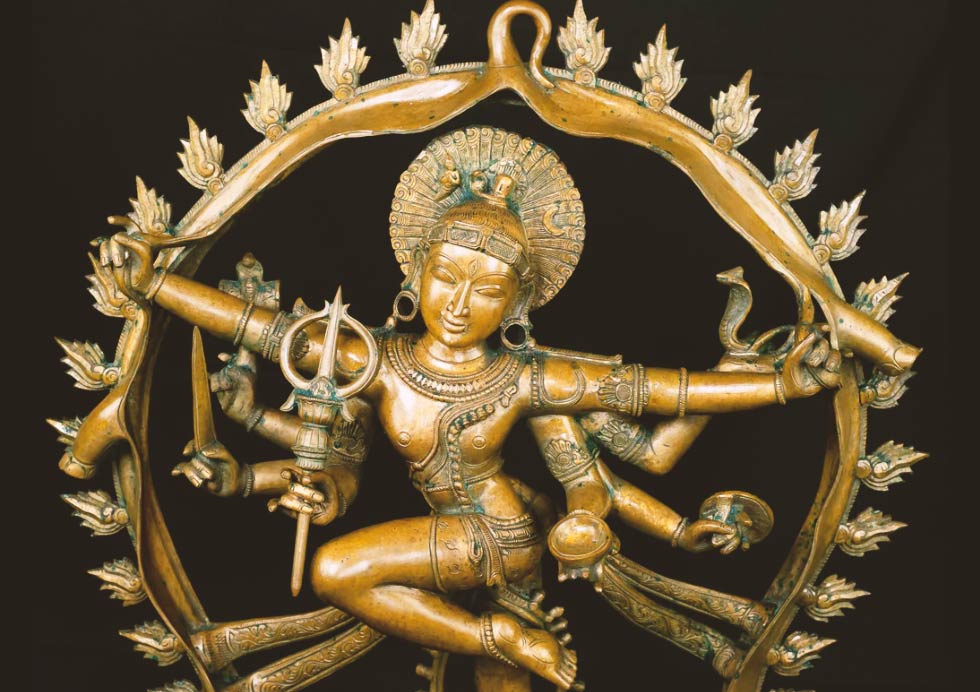
Dynamic Dance and Emphasized Body
Gajasamhara is often described as “the most dynamic of all Śaiva themes as created by South Indian sculptors.” The emphasis on Shiva’s body in this posture conveys a vigorous dance, with his right leg on the elephant’s head and the left leg lifted above, suggesting movement and dynamism. This portrayal symbolizes the cosmic order and the harmony between divine forces.
Depictions with Parvati
Gajasamhara is frequently depicted with Parvati by his side, often with a terrorized Skanda. Deviating from some iconographical treatises, some sculptures depict a calm Parvati, reassuring her frightened son with the abhaya mudra (“fear-not”) gesture. The depiction may also include other deities, musicians, skeletal goblin attendants, and Nandi and Bhringi, highlighting the complexity and richness of this divine theme.
Conclusion
The iconography of Shiva as Gajasamhara Murti unfolds a mesmerizing narrative of cosmic significance, intricate details, and dynamic symbolism. From the precision of iconographical treatises to the dynamic depictions in sculptures, every facet contributes to the profound layers of Hindu mythology. Gajasurasamhara, with its emphasis on dance, mythological roots, and dynamic portrayals, stands as a testament to the artistic prowess and spiritual depth of South Indian sculptors in capturing the essence of divine narratives.

